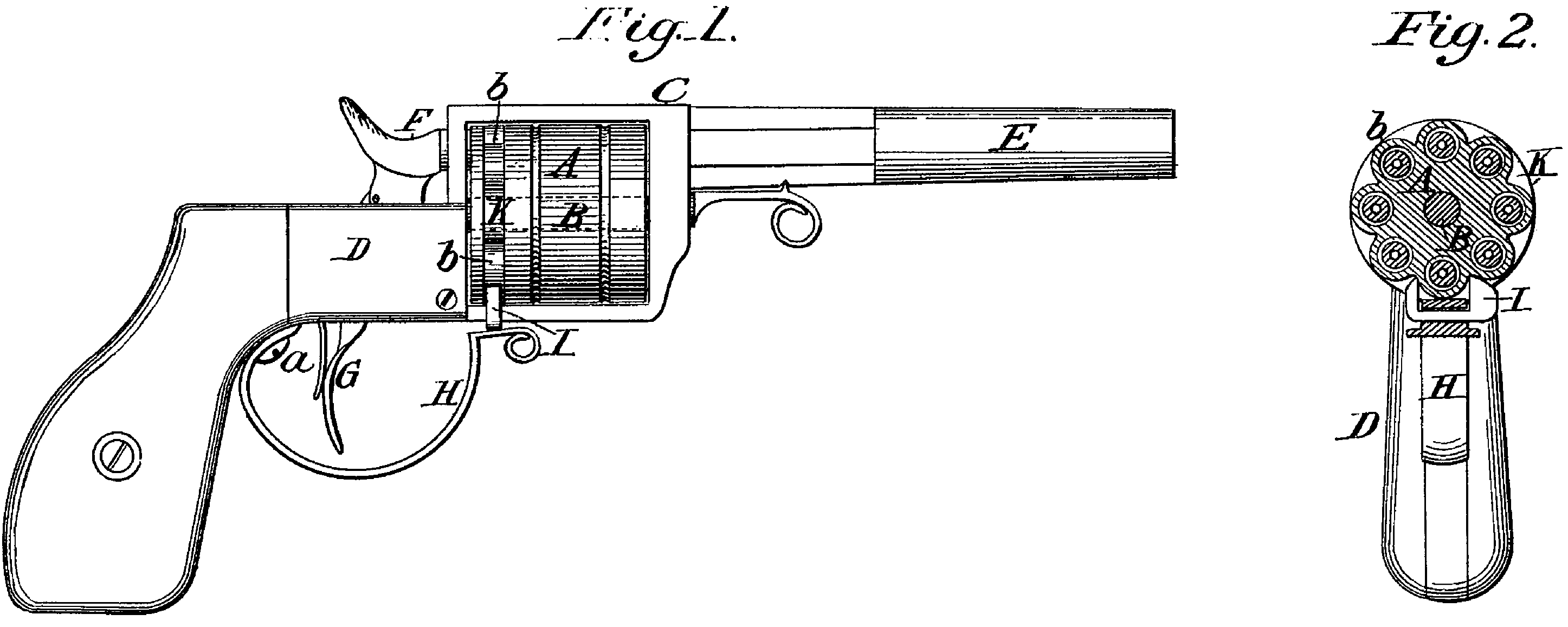US 10821
UNITED STATES PATENT OFFICE
CHARLES BUSS, OF MARLBOROUGH, NEW HAMPSHIRE.
IMPROVEMENT IN FIRE-ARMS.
Specification forming part of Letters Patent No. 10,821, dated April 25, 1854.
To all whom it may concern:
Be it known that I, CHARLES BUSS, of Marlborough, in the county of Cheshire and State of New Hampshire, have invented a new and useful Improvement in Repeating Fire-Arms; and I do hereby declare that the same is fully described and represented in the following specification and the accompanying drawings, letters, figures, and references thereof.
Of the said drawings, Figure 1 denotes a side view of a repeating-pistol constructed with my improvement. Fig. 2 is a transverse section of it, taken through the cam index-wheel of the rotary magazine.
My repeating fire-arm is constructed with a rotary chambered magazine, A, or series of short barrels, to the breech of which a percussion-cap nipple may be applied. Such rotary magazine is to turn freely on a center-pin, B, (denoted in part by dotted lines,) which extends through the frame C, that connects to the stock D and the main barrel E of the fire-arm.
The cock or percussion-hammer is shown at F, the trigger at G, and the guard of the trigger at H. This trigger-guard is confined to the stock at its rear end only, and by a screw-pin, a, the front end of the guard being unattached to the frame, while the trigger-guard is made as a spring, so that its front end shall rest and press upwards against a straddler or catch, I, shaped as seen in Fig. 2. This straddler or catch is made to rest against the periphery of a toothed index or cam wheel, J, which has as many teeth b b, & c., as there are charge-chambers within the magazine, there being one tooth to each charge-chamber. Each of these teeth is to be formed cam-shaped, and in such manner that when a person grasps the magazine between the fingers and thumb of his left hand, while he holds the fire-arm by his right hand, he may be able to rotate the magazine so as to move each of the charge-chambers in succession in line with the main barrel, the force applied to turn the magazine causing the spring trigger-guard to give way and allow of such rotation. As soon, however, as this force ceases its action the reaction of the spring-guard pressed the straddler or catch piece I upward against the index-wheel, and with power sufficient not only to bring a charge-chamber into line with the barrel, but to hold it there during the explosion of its charge. By turning the magazine a short distance farther the next charge-chamber of the series may be brought into line with the barrel and held there during a discharge of its contents. So each chamber can be operated on in succession.
My improvement consists in so making the trigger-guard, substantially as described, that it shall perform two offices — viz, that of the guard to the trigger and spring to press the straddler or index-holder up against the magazine. In doing this it will be perceived that I can not only employ a very powerful spring to hold the magazine in place during a discharge, but such spring is under the control of the finger which operates the trigger, so that, if necessary, such spring may be forced downward by such finger while the magazine is being turned. The cam-wheel, being thus relieved from strain of the spring, is not so liable to be worn as it would be were the whole power of the spring allowed to press on the straddler while the magazine was being turned on its pin.
What, therefore, I claim is —
The improvement of making the trigger-guard so that it shall not only perform the function of a guard to the trigger, but that of a spring to press the straddler or index-holder against the catch-wheel, as specified.
In testimony whereof I have hereto set my signature.
CHARLES BUSS.
Witnesses:
WILLIAM BOYDEN,
JONAH DAVIS.

